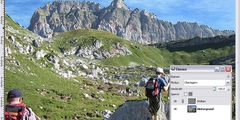Algebra help w/script
This discussion is connected to the gimp-user-list.gnome.org mailing list which is provided by the GIMP developers and not related to gimpusers.com.
This is a read-only list on gimpusers.com so this discussion thread is read-only, too.
| Algebra help w/script | Eric Pierce | 07 Mar 05:48 |
| Algebra help w/script | Steve Stavropoulos | 07 Mar 08:16 |
Algebra help w/script
(Stop reading now - This is your only warning)
Ok, I'm struggling on some algebra here for a Script-fu plug-in I'm working on.
The plug-in is an automation of this rounded corners tutorial: http://gug.sunsite.dk/tutorials/rounded-corners
Essentially, this tutorial blurs a black and white image w/90 degree corners, and then applies levels to bring the blurred edges back to a tight curved edge (i.e., the technique rounds all corners in a black/white image). The level tool's black input slider and the white input slider must adjust in relation to the blur radius, and that's where I'm stuck.
The tutorial uses levels 119 (black slider) and 135 (white slider), which works fine for a blur radius of 20px. However, to use a different blur radius (to achieve greater/lesser rounding of corners), the black and white input sliders must adjust appropriately. For example, if I do a blur radius of only 10px, 111 (black) and 142 (white) give the desired result (i.e., a tight rounded corner with all excess blur removed).
Now I did some manual sampling of different blur radius to see if I could find a relation between the blur radius and the black/white slider settings. My results make what looks like a y=1/x^2 type graph, but it needs a little tweaking.
Here's my data.
Radius Black White diff (White - Black)
0 0 255 255
2 70 183 113
4 93 160 67
6 102 151 49
8 108 145 37
10 111 142 31
12 114 139 25
14 115 138 23
16 117 136 19
18 118 135 17
20 119 134 15
22 119 134 15
24 120 133 13
26 120 133 13
28 121 132 11
30 121 132 11
32 121 132 11
34 122 131 9
36 122 131 9
38 122 131 9
40 122 131 9
42 123 130 7
44 123 130 7
46 123 130 7
48 123 130 7
50 123 130 7
52 123 130 7
54 123 130 7
56 124 129 5
58 124 129 5
60 124 129 5
62 124 129 5
64 124 129 5
66 124 129 5
68 124 129 5
70 124 129 5
72 124 129 5
74 124 129 5
76 124 129 5
78 124 129 5
80 124 129 5
82 125 129 4
84 125 129 4
86 125 128 3
88 125 128 3
90 125 128 3
I've made a spreadsheet to graph this data (i.e., add to the confusion). http://epierce.freeshell.org/gimp/selection_rounded_stats.gnumeric
Now if I can just figure out the relationship (i.e., equation) between the radius (1st column) and the diff (4th column), that should be all I need to determine what the black/white slider settings should be for all cases. My best stab is 'diff=(1/radius^2)*255*radius'. But this produces slightly skewed results.
Anyway, thanks for reading! Eric P.
Algebra help w/script
On Mon, 7 Mar 2005, Eric Pierce wrote:
The level tool's black input slider and the white input slider must adjust in relation to the blur radius, and that's where I'm stuck.
Now I did some manual sampling of different blur radius to see if I could find a relation between the blur radius and the black/white slider settings. My results make what looks like a y=1/x^2 type graph, but it needs a little tweaking.
Here's my data. Radius Black White diff (White - Black) 0 0 255 255
2 70 183 113
4 93 160 67
6 102 151 49
...
86 125 128 3
88 125 128 3
90 125 128 3Now if I can just figure out the relationship (i.e., equation) between the radius (1st column) and the diff (4th column), that should be all I need to determine what the black/white slider settings should be for all cases. My best stab is 'diff=(1/radius^2)*255*radius'. But this produces slightly skewed results.
As I see it, you have all the data you need. Make an array with your experimental results and use that. Just do an interpolation where needed (for the odd blur radius). There is no point in trying to find a mathematical model for this, if you already know everything you need.











